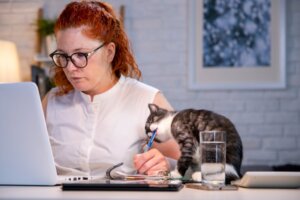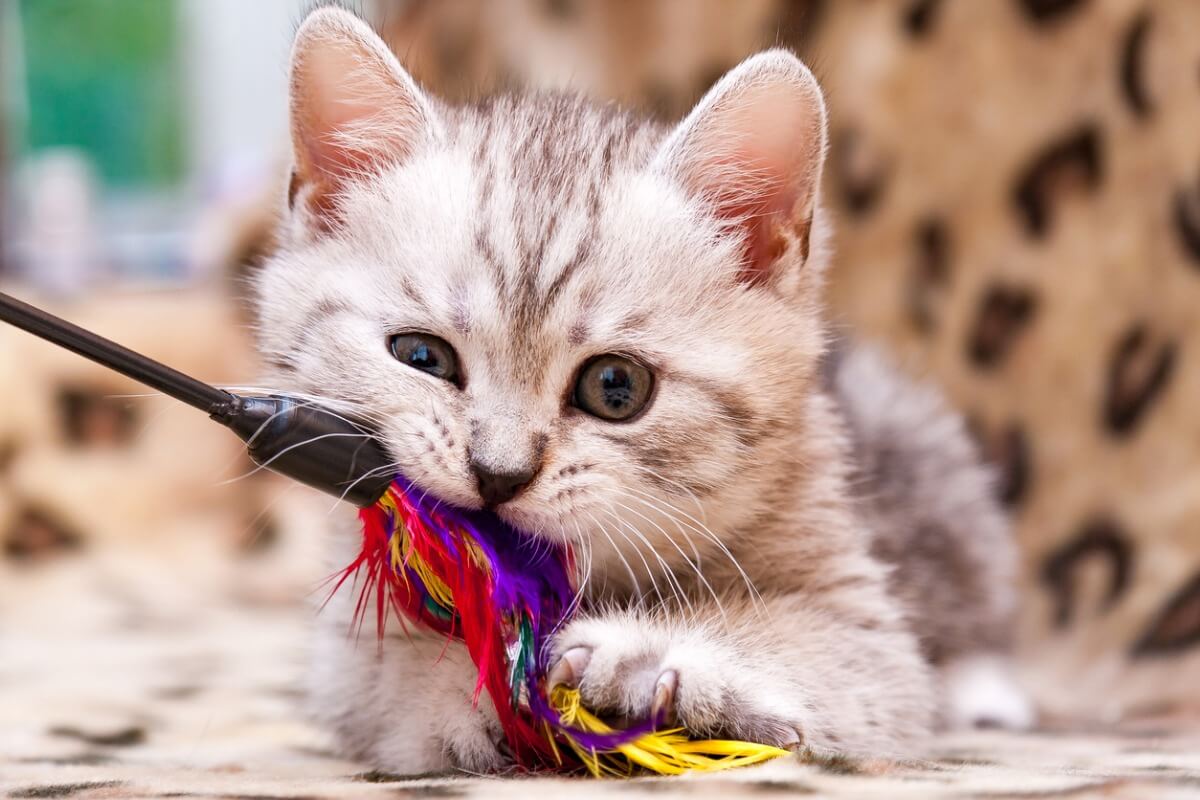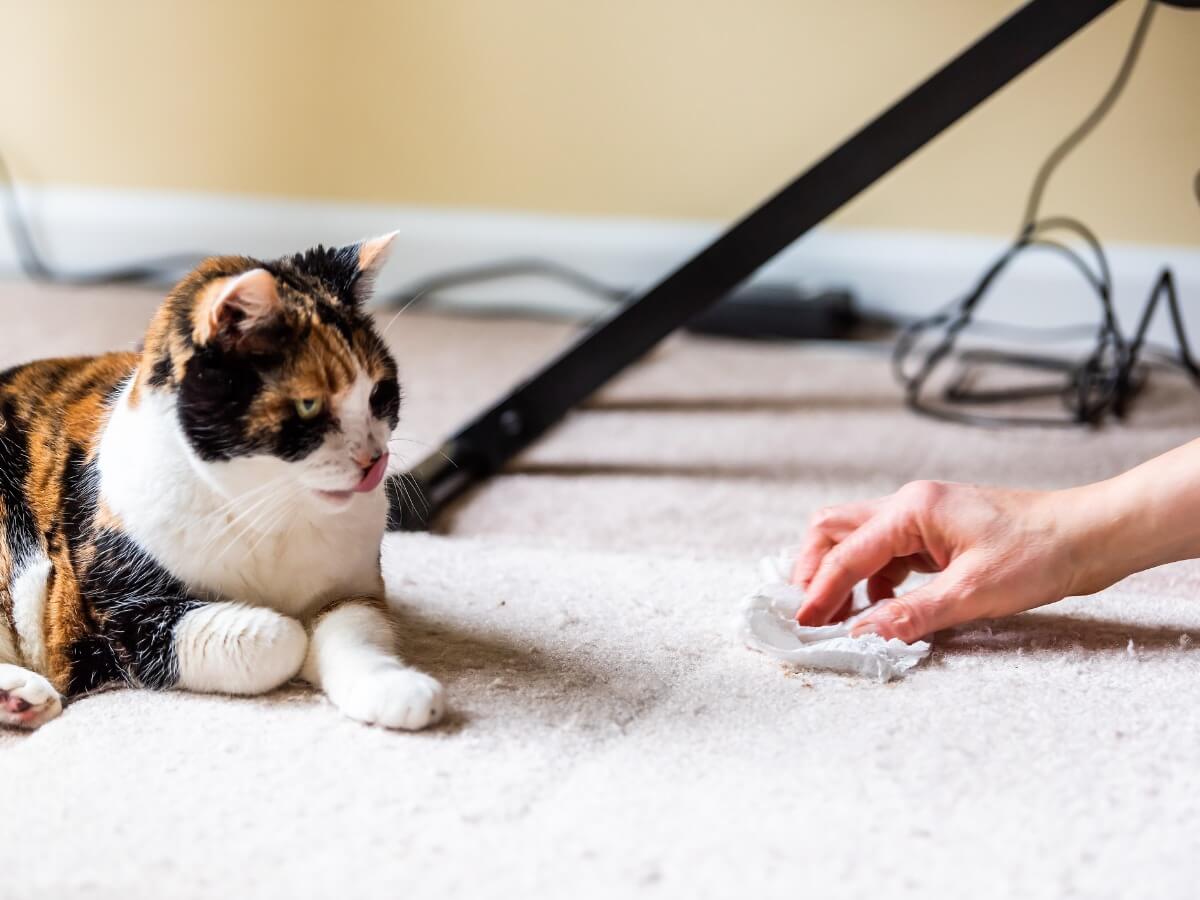My Cat Eats Plastic or Fabric: What Can I Do?

There’s an eating disorder called pica that is present in both humans and pets. This is where people or animals regularly eat things that aren’t food. This can be seen when a cat eats plastic, fabric, or other objects that should never be eaten.
If your cat seems to have this condition, pay attention when they’re near plastic items and help to prevent them from swallowing them, as they can cause vomiting and are dangerous for them. There are several reasons why a cat eats plastic, fabric or other items, and here you can learn about several of them.
Out of curiosity
This reason isn’t always the answer to everything. However, it’s an option to consider because of how curious cats tend to be, especially when they see something for the first time. Felines find everything interesting and sometimes can’t resist chewing on new items, says the National Association of Professional Pet Groomers.
Your cat eats plastic or fabric due to stress and anxiety
Just as humans sometimes bite their nails when they’re nervous or stressed, something similar happens with cats, as they can also find relief by biting some objects in their environment. If you realize that there has been a change that is likely to have caused them stress or anxiety, then this is probably the reason.
However, no matter how sure you are of the diagnosis, it’s always good to take the animal to the vet to rule out other potential problems. In addition, the change that is causing your cat so much discomfort should be gently eliminated or reintroduced.
Obsessive-compulsive disorder (OCD) can also be another reason why your cat eats plastic, cloth, or other items. This is actually another cause of stress and can even make your pet forget about other normal activities. This illness must be treated in all cases with the help of a trainer.

Due to lack of nutrients
If your cat doesn’t receive essential nutrients and is deficient in this area, it’s very likely that they will want to chew on other things frequently to satisfy this deficiency. It’s a form of impulse that their body causes it to want to get what it’s lacking and what it needs to survive.
This is one more reason to go to the vet and evaluate if your cat needs to change its diet. In addition, it’s also important that you find out exactly what your cat’s nutritional needs are, in order to get to know all the nutrients and properties of the food that you give them.
Almost the entire cat diet should be made up of animal protein and fat. It’s a strictly carnivorous species.
Because it’s bored
It’s important that you take time to play with your cat on a daily basis, as boredom is one of the reasons why they may feel the need to chew on foreign objects. To stimulate your pet, you can use cat toys that mimic their prey, in order to satisfy their predatory instinct. Obtaining objects that they can safely use when you’re not there is also important.
Due to its predatory instinct
Sometimes, this behavior is due only to the pure instinct your cat has, as some objects seem like prey to them. However, it’s not too difficult to tell when it’s doing it with these intentions and when it isn’t. If, for example, a plastic bag is moving, the cat will probably want to attack it and try to eat it.
Because it can smell something that catches its attention
Your cat has probably smelt some food that it finds interesting, and that’s why it has the desire to bite and lick inedible material. The most important thing here is to keep these food-soaked items away from it, or, failing that, to wash them well to avoid confusion.
Because of illness or disease
Some health conditions can be the cause of your cat eating plastic, fabric, or other inedible items. Among the most frequent are diabetes, dental problems, anemia, hyperthyroidism, and, in some cases, oral or brain tumors. The older the cat, the more one should suspect of physical illnesses.
How to prevent your cat from eating fabric or plastic
The most obvious solution would be not to leave any objects that your cat usually chews within reach. However, there are also other things you can do to prevent them from eating plastic and causing harmful side effects. We highlight the following:
- Take time to play with your cat and get suitable toys for them. This will make them feel happy and relaxed.
- Provide scratching places around the house. Marking the territory is one of the ways cats relieve stress, and with this option, the cat is far less likely to chew strange objects.
- While you’re not at home, give them other forms of entertainment. To keep them busy, you can make puzzle toys available to them.
What if my cat eats plastic or fabric?
You may think that chewing foreign objects is a game for your cat. However, the most important thing is to prevent the cat from swallowing the items, as this can cause illness and endanger their life. When cats eat plastic or other materials, their body is likely to react with these symptoms:
- Diarrhea
- Lethargy
- Drooling and vomiting
- Loss of appetite
- Abdominal pain
These signs are not necessarily due to having ingested foreign objects, but if you have seen your cat do it or suspect it for any reason, then it’s likely to be because of this. The important thing here is to react in time and take them to the vet as soon as possible to examine them and determine the cause of their unusual behavior.

As you can see, there’s more than one explanation why your cat eats plastic or fabric. It may indicate an underlying health condition, or it may also be triggered by simple curiosity. Whatever the trigger, determining it is critical in order to address the behavior.
There’s an eating disorder called pica that is present in both humans and pets. This is where people or animals regularly eat things that aren’t food. This can be seen when a cat eats plastic, fabric, or other objects that should never be eaten.
If your cat seems to have this condition, pay attention when they’re near plastic items and help to prevent them from swallowing them, as they can cause vomiting and are dangerous for them. There are several reasons why a cat eats plastic, fabric or other items, and here you can learn about several of them.
Out of curiosity
This reason isn’t always the answer to everything. However, it’s an option to consider because of how curious cats tend to be, especially when they see something for the first time. Felines find everything interesting and sometimes can’t resist chewing on new items, says the National Association of Professional Pet Groomers.
Your cat eats plastic or fabric due to stress and anxiety
Just as humans sometimes bite their nails when they’re nervous or stressed, something similar happens with cats, as they can also find relief by biting some objects in their environment. If you realize that there has been a change that is likely to have caused them stress or anxiety, then this is probably the reason.
However, no matter how sure you are of the diagnosis, it’s always good to take the animal to the vet to rule out other potential problems. In addition, the change that is causing your cat so much discomfort should be gently eliminated or reintroduced.
Obsessive-compulsive disorder (OCD) can also be another reason why your cat eats plastic, cloth, or other items. This is actually another cause of stress and can even make your pet forget about other normal activities. This illness must be treated in all cases with the help of a trainer.

Due to lack of nutrients
If your cat doesn’t receive essential nutrients and is deficient in this area, it’s very likely that they will want to chew on other things frequently to satisfy this deficiency. It’s a form of impulse that their body causes it to want to get what it’s lacking and what it needs to survive.
This is one more reason to go to the vet and evaluate if your cat needs to change its diet. In addition, it’s also important that you find out exactly what your cat’s nutritional needs are, in order to get to know all the nutrients and properties of the food that you give them.
Almost the entire cat diet should be made up of animal protein and fat. It’s a strictly carnivorous species.
Because it’s bored
It’s important that you take time to play with your cat on a daily basis, as boredom is one of the reasons why they may feel the need to chew on foreign objects. To stimulate your pet, you can use cat toys that mimic their prey, in order to satisfy their predatory instinct. Obtaining objects that they can safely use when you’re not there is also important.
Due to its predatory instinct
Sometimes, this behavior is due only to the pure instinct your cat has, as some objects seem like prey to them. However, it’s not too difficult to tell when it’s doing it with these intentions and when it isn’t. If, for example, a plastic bag is moving, the cat will probably want to attack it and try to eat it.
Because it can smell something that catches its attention
Your cat has probably smelt some food that it finds interesting, and that’s why it has the desire to bite and lick inedible material. The most important thing here is to keep these food-soaked items away from it, or, failing that, to wash them well to avoid confusion.
Because of illness or disease
Some health conditions can be the cause of your cat eating plastic, fabric, or other inedible items. Among the most frequent are diabetes, dental problems, anemia, hyperthyroidism, and, in some cases, oral or brain tumors. The older the cat, the more one should suspect of physical illnesses.
How to prevent your cat from eating fabric or plastic
The most obvious solution would be not to leave any objects that your cat usually chews within reach. However, there are also other things you can do to prevent them from eating plastic and causing harmful side effects. We highlight the following:
- Take time to play with your cat and get suitable toys for them. This will make them feel happy and relaxed.
- Provide scratching places around the house. Marking the territory is one of the ways cats relieve stress, and with this option, the cat is far less likely to chew strange objects.
- While you’re not at home, give them other forms of entertainment. To keep them busy, you can make puzzle toys available to them.
What if my cat eats plastic or fabric?
You may think that chewing foreign objects is a game for your cat. However, the most important thing is to prevent the cat from swallowing the items, as this can cause illness and endanger their life. When cats eat plastic or other materials, their body is likely to react with these symptoms:
- Diarrhea
- Lethargy
- Drooling and vomiting
- Loss of appetite
- Abdominal pain
These signs are not necessarily due to having ingested foreign objects, but if you have seen your cat do it or suspect it for any reason, then it’s likely to be because of this. The important thing here is to react in time and take them to the vet as soon as possible to examine them and determine the cause of their unusual behavior.

As you can see, there’s more than one explanation why your cat eats plastic or fabric. It may indicate an underlying health condition, or it may also be triggered by simple curiosity. Whatever the trigger, determining it is critical in order to address the behavior.
All cited sources were thoroughly reviewed by our team to ensure their quality, reliability, currency, and validity. The bibliography of this article was considered reliable and of academic or scientific accuracy.
Manuales MSD. (s. f.). Pica. Manual MSD versión para público general. Recuperado 5 de septiembre de 2021, de https://www.msdmanuals.com/es-co/hogar/trastornos-de-la-salud-mental/trastornos-de-la-conducta-alimentaria/pica
NATIONAL ASSOCIATION OF PROFESSIONAL PET SITTERS. (s. f.). Why Does my Cat Eat Plastic (Reasons & Prevention). Recuperado 5 de septiembre de 2021, de https://petsitters.org/page/WhyDoesmyCatEatPlasticReasonsPrevention
This text is provided for informational purposes only and does not replace consultation with a professional. If in doubt, consult your specialist.








